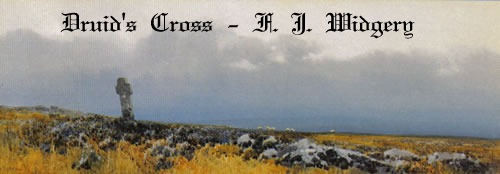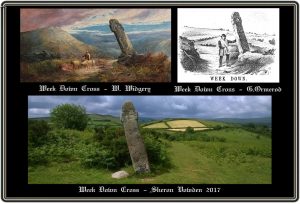
“Regaining the road, I go on towards Moreton, taking another circuitous route to visit the fine old cross on Week Down, just above Middlecott. It has an incised Maltese Cross on both sides at the intersection of the arms, which are probably more modern than the cross itself, as the former are upright, whilst the latter leans at a considerable angle.”
John Chudleigh, 1892, p.51
High on the hill sits a lonely cross… and Week Down cross has sat there for centuries, probably since medieval times. Although today it is not in its original location the cross has faithfully served as a wayside cross and marked an early track. Starkey (1989, p.78) suggests that the track would have been one of the main routes which ran from North Bovey and Moretonhampstead into Chagford and would also have served as a church path for those living in the outlying farms. The seemingly precarious angle at which the cross leans sets it apart from most of the ancient crosses of Dartmoor. In 1859, Ormerod reported that the shaft was 15º 30′ out of the perpendicular and then in 1867 the roadside bank on which it stood collapsed with the result that the angle increased to 18º, (Harrison, 2001 p.254). As a few ton of teetering granite stood beside a trackway it soon became obvious that the cross presented a danger to travellers and something had to be done. An enterprising farmer from Great Week offered to remove the hazard with the intention of using it as a footbridge which would save him a great deal of time and effort in hewing such a structure from moorstone. Luckily some unknown person intervened and the cross was saved its impending indignity by being re-erected albeit further onto the common. The cross was actually restored with its original tilt which it still retains today as can be seen from the various images below. As there was no socket stone provided the restorers packed four large slabs around the cross’s base to hold it in place. Although Week Down Cross stands at an impressive 1.94m its stumpy arms only stretch to a span of 47cm and are orientated in a NNE – SSW direction. The circumference of the shaft is 1.345m at its widest point and there is a Maltese Cross incised on both faces. The one on the south western face is 22cm high and spans 18cm and the one on the north western face is slightly larger measuring 24cm high and spanning 23cm, (Sandles, 1997, p.108). Crossing (1987, p.138) notes one thing regarding the incised crosses:
“That on the eastern has its limbs parallel to the shaft and arms of the cross on which it is graven, but the one on the western face has not. Here the Maltese cross is upright, and a line drawn through it would fall little distance from the foot of the old stone. This would seem to show that it was incised after the cross had fallen out of the perpendicular, and though the position of the other does not indicate this, it is probable they were both cut at the same time“.
Which basically means that the Maltese crosses were cut into the cross sometime after it had been originally erected and had already gained its tilt. The other mystery with this cross is that on the north face of the cross the letters ‘I A’ have been, to steal Crossing’s splendid word, “graven”. Nobody seems to know who or what ‘I A’ represents but maybe it’s the initials of the person who restored the cross? Finally, it is suggested by Historic England that due to the “primitive style” of the cross it may possibly have prehistoric origins? This seems an odd statement as compared with other Dartmoor crosses it is quite stylish. One interesting note, in 1886 The Devon and Exeter Gazette reported that at one time a “devout Catholic” would visit the cross every morning to wash it and on festivals they would decorate the cross with flowers.
It is astonishing how one line of research can quickly transport one in a different direction only to then return to where you began and Week Down Cross is such a case. I once had (now found as can be seen below) ) an image of a painting done by F. J. Widgery that was entitled, “Druid’s Cross”, and although I had never heard of such I always thought the subject looked like Week Down Cross. There are no other Dartmoor crosses that stand on open ground and tilt at such a jaunty angle and Widgery’s cross certainly does that. Whilst looking on the Archaeological Data Service website for the area I came across a record for, “Druid’s Well”, which when plotted on the map transpired to be about half a mile from the cross. This then begs three questions; was Week Down Cross once known as Druid’s Cross, was this because of its proximity to Druid’s Well and lastly what is the Druidic connections with the area?
Just to be awkward, let’s look at the third question first, “what is the Druidic connection with the area? Firstly, when talking about the Druids it is possible to assume that we are looking at a period in the Iron Age as they were very much the priests of the time. So what evidence in the area is there for an Iron Age presence? There is plenty of evidence pertaining to the Iron Age within a five mile radius of the cross with hillforts at Cranbrook, Prestonbury, Wooston, Hunter’s Tor and a part finished one on nearby Nattadon Common. This would therefore possibly give a reason as to why at a later date there may have been supposed Druidical associations in the area. Then we come onto the place-names still to be found in and around the cross, the first and most obvious one is Druid’s Well which sits beside the road near Middlecott (SX 7163 8620). Although now in a rather rickety state, thanks to an encounter with a vehicle, the well is clearly old although its exact age is unknown, (Faull, 2004, p.72).
Just over a mile, as the crow flies, from the cross is Lower, Middle and Higher Drewston and Drewston Cross(roads), which again could indicate some Druidic connection. However, the good old place-name society blow this straight out of the water by suggesting that in 1281 the name was Thurwardeston or in other words the ‘tun (farm, homestead) of Thurweard’, (Glover et al. 1998, p.424). But just because we know this today does not mean that hundreds of years ago people did and so the ‘Druid’ idea could well have been current and plausible to them. Especially as in early folklore many of the natural features and prehistoric remains were thought to have been the work of the Druid’s, for example the rock basin on nearby Kes Tor. So to answer the question, in tradition if not reality there is an undeniable association with the Druids in the area around the cross which could have led to the well being so named.
Now the first and second questions, when reading any of the books that specialise in the ancient crosses of Dartmoor is there any reference to Week Down Cross being known as Druid’s Cross – no. But on the other hand, F. J. Widgery had a good knowledge of the moor and the majority of his works are correctly named in their titles so why should he make this one an exception? The only other disconcerting fact is that as can be seen above his father, W. Widgery, also painted Week Down cross on several occasions but he called it exactly that.

OK, I have now managed to find another image of F. J. Widgery’s Druid Cross which has been labelled ‘Druid’s Cross near Tavistock’ which I presume would refer to Pixies Cross on Whitchurch Common – see above. So an interesting theory about the Druid’s but now proven wrong – can’t get it right all of the time.

Crossing, W. 1987 The Ancient Stone Crosses of Dartmoor, Devon Books, Exeter.
Chudleigh, J. 1892. An Exploration of Dartmoor’s Antiquities. Pembury: John Pegg Pub.
Faull, T. 2004 Secrets of the Hidden Source, Halsgrove Publishing, Tiverton.
Gover, J. E. B., Mawer, A. & Stenton, F. M. 1992 The Place Names of Devon, English Place-Name Society, Nottingham.
Harrison, B. 2001 Dartmoor Stone Crosses, Halsgrove Publishing, Tiverton.
Sandles, T. 1997 A Pilgrimage to Dartmoor’s Crosses, Forest Publishing, Liverton.
Starkey, F. H. 1989 Dartmoor Crosses, Starkey, Exeter.
 Legendary Dartmoor The many aspects past and present of Dartmoor
Legendary Dartmoor The many aspects past and present of Dartmoor



I was searching for details of Keble’s Chapel, near Huntington Warren, when I discovered your website. What an eye opener,
I have done many ten tors and abbots ways over the years and have walked all of Dartmoor. In the last ten years, I have written a guide to Dartmoor.
It started off as a dozen walk, but grew I have designed it around 300 walks, with photos and my own maps etc.It has grown to about 400 maps and 6,000 photos,
If you are interested, I would very much like your help with putting it onto the internetfor all to discover for free.
Thanks for reading this,
John Partridge.